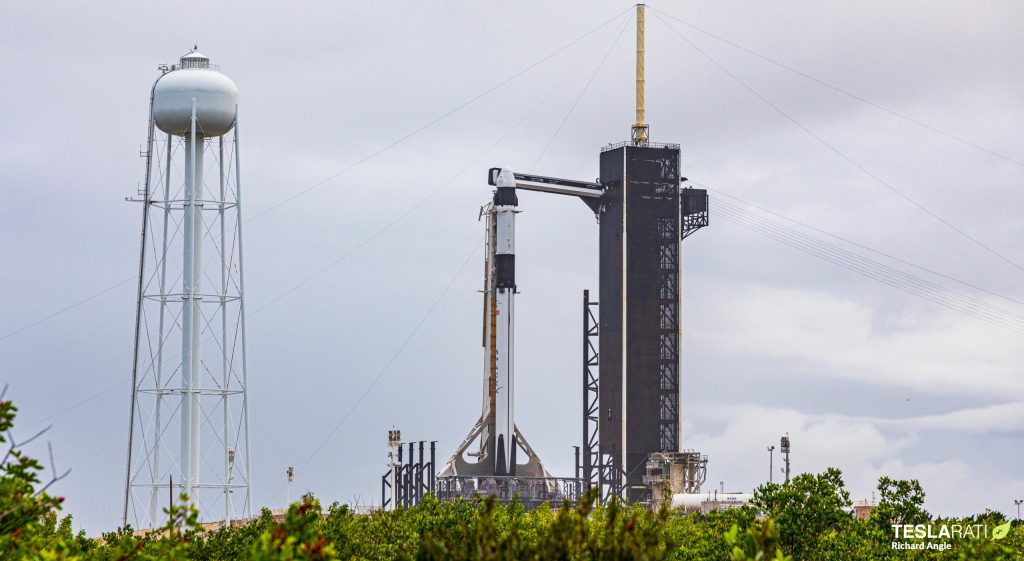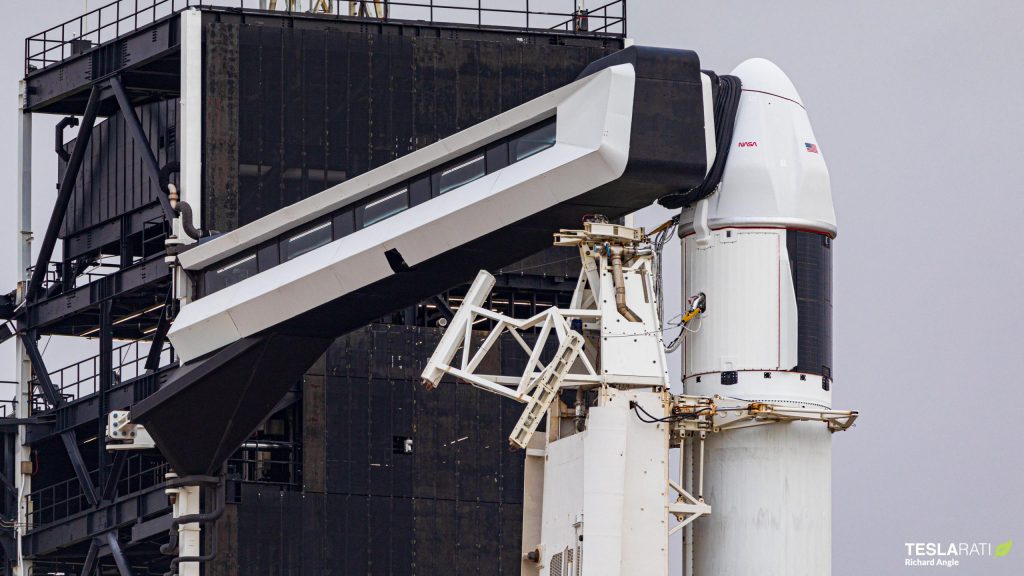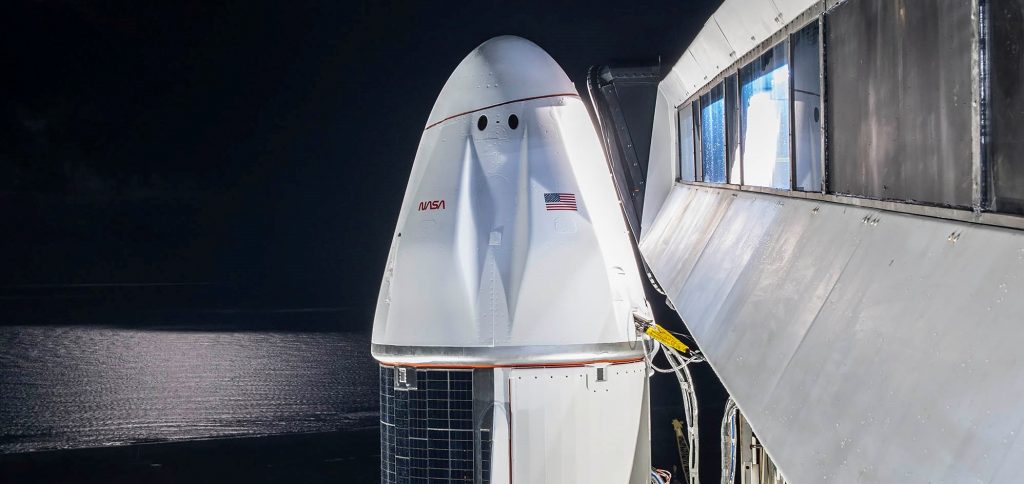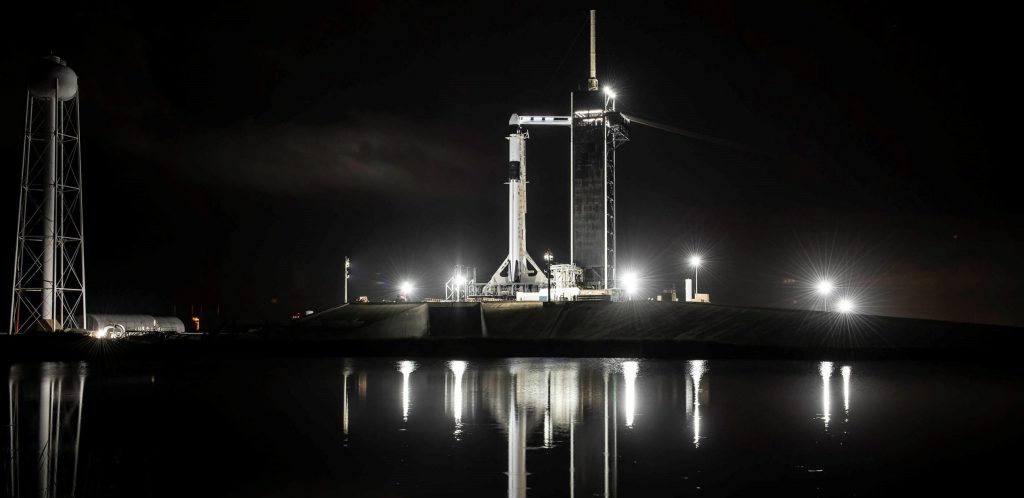Update: Despite terrible weather, SpaceX and NASA are on track to attempt to launch Cargo Dragon’s CRS-24 space station resupply mission – also Falcon 9’s 31st and last launch of 2021. Tune in below around 4:45 am EDT (09:45 UTC), December 21st to watch the mission live.


SpaceX has rolled out a rare new Falcon 9 booster for the company’s last launch of 2021, highlighting just how pervasive the company’s rocket reusability has become.
The mission – CRS-24, Cargo Dragon 2’s fourth International Space Station (ISS) resupply run – will be SpaceX’s 31st Falcon 9 launch of the year, handily beating the 26-launch record the company set in 2020. However, CRS-24 will be only the second time this year that SpaceX debuts an unflown (new) Falcon booster, meaning that all 29 other missions (~94%) successfully relied on flight-proven rockets.


In other words, in less than five years, SpaceX has gone from completing its very first Falcon 9 reuse (SES-10 – March 2017) to launching almost 30 times in one year without a single new booster. The only other time SpaceX flew a new booster this year was CRS-22, which successfully debuted Falcon 9 B1067 and the new Cargo Dragon 2 capsule C209 in June.
Six months later, Falcon 9 B1069 is scheduled to debut by launching Cargo Dragon 2 capsule C209 on its second mission to the ISS. Carrying approximately 3 tons (~6500 lb) of consumables, station parts, and science experiments, Dragon is set to lift off from Kennedy Space Center (KSC) Pad 39A no earlier than (NET) 5:06 am EDT (10:06 UTC) on Tuesday, December 21st. Weather is looking decidedly unfavorable, however, and CRS-24 currently runs a 70% chance of being scrubbed by poor conditions at Cape Canaveral and downrange in the Atlantic Ocean. Weather forecasts for a backup window on December 22nd currently predict a much better 60% chance of favorable conditions.
Regardless, when CRS-24 launches, it will mark a number of milestones and set several new records for SpaceX. Beyond firming up SpaceX’s record-breaking 31 launches this year, CRS-24 will also be the third Falcon launch in just 69 hours – less than three days. Before it, SpaceX’s three-launch record was most recently set in November 2020 when three Falcon 9 rockets launch Crew-1, Sentinel 6A, and Starlink V1 L15 a little over nine days (~217 hours) apart. If SpaceX can find a gap in the half-figurative clouds and launches on December 21st, it will beat that record by more than a factor of three.
Additionally, including Starlink 4-3 and NASA’s IXPE mission, CRS-24 will be SpaceX’s fifth orbital launch in December 2021 – the first time the company has launched more than four times in one month. Even more impressively, if CRS-24 lifts off before Thursday, December 23rd, it will actually be SpaceX’s fifth launch in less than three weeks. If it wasn’t December, SpaceX could have quite possibly squeezed a sixth launch into the last few days of the year. Instead, most SpaceXers will get some well-deserved time off before 2022 begins.
Incredibly, even excluding Starlink missions, which made up more than half of SpaceX’s 2021 launches, the company has at least 39 commercial Falcon launches tentatively scheduled in 2022. If it wants to continue regular Starlink launches on top of its unprecedently packed manifest, it won’t be long at all before SpaceX’s next five-launch month.

News
Tesla Giga Shanghai celebrates 5 million electric drive unit milestone
The milestone was celebrated by the company in a post on its official Weibo account.

Tesla China has reached another manufacturing milestone at Gigafactory Shanghai, rolling out the facility’s 5 millionth locally produced drive unit.
The milestone was celebrated by the company in a post on its official Weibo account. In its post, the Giga Shanghai team could be seen posing with the 5 millionth drive unit.
Giga Shanghai’s major benchmark
The milestone drive unit was produced at Gigafactory Shanghai, which produces the Model Y and the Model 3. In a release, Tesla China noted that its three-in-one integrated electric drive system combines the motor, gearbox, and inverter into a single compact assembly. This forms a powerful “heart” for the company’s electric cars.
Tesla China also noted that its drive units’ integrated design improves energy conversion efficiency while reducing overall weight and complexity, benefits that translate into stronger performance, improved handling, and longer service life for its vehicles.

The new milestone builds on earlier achievements at the same site. In July 2024, Tesla announced that its 10 millionth electric drive system globally had rolled off the line at the Shanghai plant, making it the first self-produced Tesla component to reach that volume.
More recently, the factory also produced its 4 millionth China-made vehicle, a Model Y L. The factory has also continued hitting global production milestones, rolling out Tesla’s 9 millionth EV worldwide late last year, with the landmark vehicle being a Tesla Model Y.
Tesla China’s role
Construction of Giga Shanghai began in January 2019, with production starting by the end of that year. This made it the first wholly foreign-owned automotive manufacturing project in China. The facility began delivering Model 3 vehicles locally in early 2020 and added Model Y production in 2021. The plant is now capable of producing about 1 million vehicles annually.

Throughout 2025, Giga Shanghai delivered 851,732 vehicles, representing a 7.08% year-on-year decline, according to data compiled by CNEVPost. Even so, recent months showed renewed momentum.
In December alone, Tesla China recorded wholesale sales of 97,171 vehicles, including domestic deliveries and exports, making it the company’s second-best monthly total on record, per data from the China Passenger Car Association. Retail sales during December reached roughly 94,000 units, up about 13% year over year.
Investor's Corner
Tesla price target boost from its biggest bear is 95% below its current level

Tesla stock (NASDAQ: TSLA) just got a price target boost from its biggest bear, Gordon Johnson of GLJ Research, who raised his expected trading level to one that is 95 percent lower than its current trading level.
Johnson pushed his Tesla price target from $19.05 to $25.28 on Wednesday, while maintaining the ‘Sell’ rating that has been present on the stock for a long time. GLJ has largely been recognized as the biggest skeptic of Elon Musk’s company, being particularly critical of the automotive side of things.
Tesla has routinely been called out by Johnson for negative delivery growth, what he calls “weakening demand,” and price cuts that have occurred in past years, all pointing to them as desperate measures to sell its cars.
Johnson has also said that Tesla is extremely overvalued and is too reliant on regulatory credits for profitability. Other analysts on the bullish side recognize Tesla as a company that is bigger than just its automotive side.
Many believe it is a leader in autonomous driving, like Dan Ives of Wedbush, who believes Tesla will have a widely successful 2026, especially if it can come through on its targets and schedules for Robotaxi and Cybercab.
Justifying the price target this week, Johnson said that the revised valuation is based on “reality rather than narrative.” Tesla has been noted by other analysts and financial experts as a stock that trades on narrative, something Johnson obviously disagrees with.
Dan Nathan, a notorious skeptic of the stock, turned bullish late last year, recognizing the company’s shares trade on “technicals and sentiment.” He said, “From a trading perspective, it looks very interesting.”
Tesla bear turns bullish for two reasons as stock continues boost
Johnson has remained very consistent with this sentiment regarding Tesla and his beliefs regarding its true valuation, and has never shied away from putting his true thoughts out there.
Tesla shares closed at $431.40 today, about 95 percent above where Johnson’s new price target lies.
News
I subscribed to Tesla Full Self-Driving after four free months: here’s why
It has been incredibly valuable to me, and that is what my main factor was in considering whether to subscribe or not. It has made driving much less stressful and much more enjoyable.

I have been lucky enough to experience Tesla Full Self-Driving for the entire duration of my ownership experience for free — for four months, I have not had to pay for what I feel is the best semi-autonomous driving suite on the market.
Today, my free trial finally ran out, and I had two choices: I could go without it for a period until I felt like I absolutely needed it, or I could subscribe to it, pay $99 per month, and continue to experience the future of passenger transportation.
I chose the latter, here’s why.
Tesla Full Self-Driving Takes the Stress Out of Driving
There are a handful of driving situations that I don’t really enjoy, and I think we all have certain situations that we would just rather not encounter. This is not to say that I won’t ever experience them as someone who has driven a car for 15 years (it feels weird saying that).
I don’t love to drive in cities; I really don’t like driving on I-695 on my way to Baltimore, and I truly hate parallel parking. All three things I can do and have done, all three within the past few weeks, too.
It takes all the stress out of city driving pic.twitter.com/q0SPPrH4HU
— TESLARATI (@Teslarati) December 4, 2025
However, if I can avoid them, I will, and Tesla Full Self-Driving does that for me.
Tesla Full Self-Driving Eliminates the Monotony
I drive to my alma mater, Penn State University, frequently in the Winter as I am a season ticket holder to Wrestling and have been for 16 years now.
The drive to State College is over two hours and over 100 miles in total, and the vast majority of it is boring as I travel on Rt 322, which is straight, and there is a lot of nature to look at on the way.
I am willing to let the car drive me on that ride, especially considering it is usually very low traffic, and the vast majority of it is spent on the highway.
The drive, along with several others, is simply a boring ride, where I’d much rather be looking out the windshield and windows at the mountains. I still pay attention, but having the car perform the turns and speed control makes the drive more enjoyable.
Tesla Full Self-Driving Makes Navigating Easier
Other than the local routes that I routinely travel and know like the back of my hand, I’ve really enjoyed Full Self-Driving’s ability to get me to places — specifically new ones — without me having to constantly check back at the Navigation.
Admittedly, I’ve had some qualms with the Nav, especially with some routing and the lack of ability to choose a specific route after starting a drive. For example, it takes a very interesting route to my local Supercharger, one that nobody local to my area would consider.
But there are many times I will go to a new palce and I’m not exactly sure where to go or how to get there. The Navigation, of course, helps with that. However, it is really a luxury to have my car do it for me.
To Conclude
There was no doubt in my mind that when my Full Self-Driving trial was up, I’d be subscribing. It was really a no-brainer. I am more than aware that Full Self-Driving is far from perfect, but it is, without any doubt, the best thing about my Tesla, to me.
It has been incredibly valuable to me, and that is what my main factor was in considering whether to subscribe or not. It has made driving much less stressful and much more enjoyable.
🚨 How I’ve gotten Tesla Full Self-Driving for free…until now
Watch me subscribe to Tesla FSD! https://t.co/bjK7EEOptR pic.twitter.com/cs5CmN5PdJ
— TESLARATI (@Teslarati) January 7, 2026










